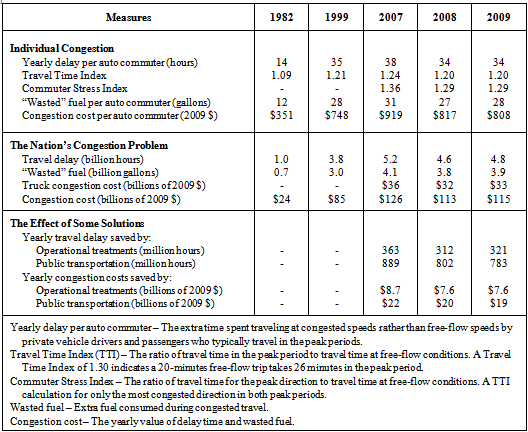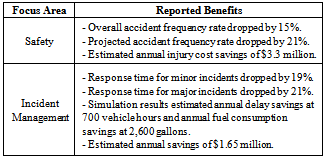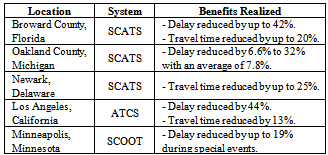-
Paper Information
- Previous Paper
- Paper Submission
-
Journal Information
- About This Journal
- Editorial Board
- Current Issue
- Archive
- Author Guidelines
- Contact Us
Science and Technology
p-ISSN: 2163-2669 e-ISSN: 2163-2677
2013; 3(1): 33-41
doi:10.5923/j.scit.20130301.04
Traffic Signal Systems: A Review of Current Technology in the United States
Ashley Russell Kotwal , Soon Jae Lee , Yoo Jae Kim
Department of Engineering Technology, Texas State University, San Marcos, Texas 78666
Correspondence to: Yoo Jae Kim , Department of Engineering Technology, Texas State University, San Marcos, Texas 78666.
| Email: |  |
Copyright © 2012 Scientific & Academic Publishing. All Rights Reserved.
Traffic signal systems have been employed since the early twentieth century as a method of continuously managing traffic flow and saturation at intersections and to promote smooth and safe automobile transportation. Due to the continuous increase of traffic congestion in urban areas, there is a need for further evaluation and implementation of traffic signal systems. This study reviews and consolidates information on a wide variety of signal systems, detection devices and communications components in order to provide a cogent understanding of current technology in the United States. Additionally, the assessment focuses on operational functions of various systems, and thereby, establishes what the systems’ capabilities are when utilized to their fullest extent. Current signal system practices are reviewed to compare existing technologies, and postmodern technologies are investigated. Recommendations for further investigation of traffic signal systems are also provided.
Keywords: Transportation, Traffic Signal, Traffic Controller, Traffic Detection, Intelligent Transportation Systems
Cite this paper: Ashley Russell Kotwal , Soon Jae Lee , Yoo Jae Kim , Traffic Signal Systems: A Review of Current Technology in the United States, Science and Technology, Vol. 3 No. 1, 2013, pp. 33-41. doi: 10.5923/j.scit.20130301.04.
Article Outline
1. Introduction
- Traffic signal systems have been subjected to a variety of evaluations in the scientific literature. Due to the complexity of arterial roadway systems, the assessment and comparison of transportation system deployments is often complicated by the fact that each system is unique. However, the professional interest associated with increasing the safety and effectiveness of traffic signal systems allows for new technologies to be developed to support each system in achieving a greater potential and more robust capability. Through a detailed review of literature, the benefits, limitations and significance of different types of traffic signal systems and their components has been determined.Traffic signals are control devices that are most commonly installed at arterial roadway intersections to carry traffic from local streets to highways. Consequently, arterial roads with speed limits between 30 and 45 miles per hour are the main focus when attempting to improve traffic flow and saturation [1]. Due to the continuous increase of traffic congestion in urban areas, transportation agencies must routinely develop new guidelines and procedures for identifying problem areas and determining the best solutions[2-3]. Improvements to an existing traffic signal system may include modification to existing functions such as signal timing, installation of detection or surveillance equipment or upgrading controllers and communications. Table 1 details the findings of the 2010 Urban Mobility Report and provides economical insight regarding the current inefficient nature of traffic signal systems in the United States[4]. Information is also provided which shows the effects of current solutions to traffic congestion.
2. Traffic Signal Controllers
- Local time based controllers are among the most fundamental traffic signal system components. These controllers operate by using programmed cycle lengths and time-of-day operations to manage traffic at intersections. If not connected to a central network controller, the local controllers must be monitored and field adjusted periodically to ensure efficient traffic operations. For this reason, the deployment of local time based controllers is not practical in arterial systems prone to high levels of traffic fluctuation, and therefore, minimal research is being conducted on fixed timing systems[5].Since the emergence of modern telecommunications systems, traffic engineers have been focusing on developing new technologies that can more accurately and efficiently control traffic. In addition to the fixed time controllers, there are currently four different types, or generations, of dynamic traffic signal controllers that are designed to communicate traffic conditions from intersections to computerized network systems[6]. All four controllers have comparable functions; however, they are each intended for use in different arterial roadway systems and for different purposes. The first generation traffic controller, the National Electrical Manufacturers Association (NEMA) TS-1, is capable of controlling two phase actuated intersections as well as offering isolated actuated control. Actuated control utilizes traffic detection devices to determine signal timing in lieu of using programmed predetermined timing. This type of dynamic control significantly reduces traffic saturation and improves traffic flow; therefore, the control capabilities provided by the NEMA TS-1 are far superior to fixed time controllers[7]. Capable of operating two to eight phase actuated intersections, the second generation traffic controller known as the Type 170 is a significant advance in controller technology. The increased number of actuated phases allows the Type 170 controller to control the through lanes and turning lanes at a four-way intersection using traffic detection devices. However, the third generation traffic controller, the NEMA TS-2, not only matches the increased control capacity of the Type 170 but also provides supplementary control and safety functions. The added safety functions include a malfunction management unit which is a warning system that will flash a red light if there is a failure in the program sequence. Figure 1 illustrates the similarities and differences between the NEMA TS-1 and NEMA TS-2 traffic controller configurations[8]. Finally, the fourth generation traffic controller, the Advance Transportation Control Type 2070 combines the features of the previous controllers, provides additional control functions and is able to communicate through different interfaces. The combined features of the Type 2070 include control of overlap data and phase timing, coordination, time-of-day lock, communication data, detector configuration and assignment, preemption for priority vehicles and utilities for event recording, diagnostic testing and reporting[7].Traffic signal controllers can provide a sophisticated and effective approach to improving traffic operations. A recent study conducted by the Texas Transportation Institute found that Type 2070 controllers have advanced features that exceed Texas Department of Transportation specifications. Although Type 2070 controllers have been deployed extensively by many transportation agencies, basic functions are typically utilized due to the time and research required to investigate advanced traffic controller features. Researchers found that “a number of coordinated features in existing signal controllers improve coordinated operations,” and can, therefore, be utilized as a cost effective method of improving signal timing. The results of the study indicate that further research in this area may be beneficial to other agencies as well[9].
|
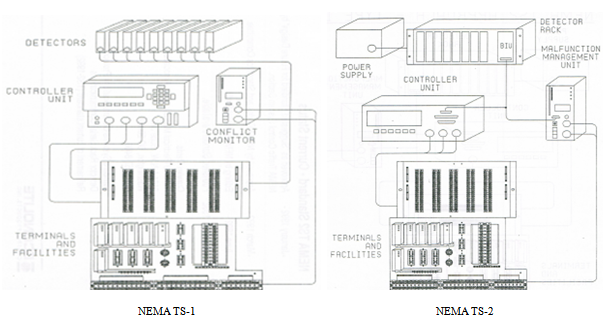 | Figure 1. Configuration of NEMA TS-1 and NEMA TS-2 Traffic Controllers[8] |
3. Detection & Surveillance Devices
- Actuated traffic signal controllers utilize a variety of detection technologies in order to determine cycle lengths and sequences. Traditional traffic detection technologies include inductive loop detectors and magnetometers; both sensors allow for factors such as traffic speed, volume and presence to be analyzed by a controller. As a conventional technology for traffic detection, inductive loops are well understood by industry professionals and are the primary means of detection in arterial systems. Inductive loops are insensitive to inclement weather and are also the most accurate means of detection if properly installed and maintained[10]. However, the installation and maintenance of inductive loops and magnetometers are typically much more expensive and invasive than more modern detection technologies as they require cutting and patching of pavement[11-12].More recently, many transportation agencies have incorporated radar, infrared, ultrasonic and acoustic traffic detection devices into their actuated control systems[13]. Unlike inductive loops and magnetometers, these vehicle detection devices are not installed in the pavement; they are typically installed on a support structure above or alongside the roadway, allowing for an uninhibited view of the traffic[14]. Benefits of using this type of detection include preventing unnecessary damage to the pavement, improving ease of maintenance and increasing the coverage area. However, the sensors are typically more sensitive to inclement weather when compared to detection devices installed in the roadway. In addition to providing traffic speed, volume and presence, sensors installed above the roadway can also provide vehicle classification and multiple lane coverage. By providing more accurate and detailed information over a larger area, these detection devices have great potential to reduce motorist delay and fuel consumption[10].Video imagery can also be used for surveillance and monitoring of arterial roadway systems through the use of video detection cameras. The ability to observe live traffic conditions allows transportation agencies to gather information in order to provide real time traffic updates to drivers and assist emergency response personnel. Table 2 reports benefits that were witnessed from implementing a video surveillance system in San Antonio, Texas[15]. Video image processing is a superior detection technology when implemented correctly, providing a rich array of data over a wide area of coverage. Video image processors (VIP) are able to collect information over multiple lanes and output data to controllers regarding traffic count, presence, speed, occupancy and classification. Some systems also have the ability to recognize license plates and even track moving vehicles[16]. Due to the large amount of information transmitted, VIPs may require a high bandwidth communications system. The requirements of the communications system depend on whether raw data, processed data or video imagery is transmitted. VIPs are by far the most expensive of the commercially available sensors; however, the cost can be justified if a transportation agency utilizes a single VIP in lieu of several other sensors to fully instrument an intersection[10].To monitor traffic operations on 30,500 miles of freeway, the California Department of Transportation has deployed an extensive traffic detection network composed of over 25,000 sensors. This network provides a plethora of information, including vehicle occupancy and volume, to traffic engineers through a combination of inductive loop detectors, radar detectors and other devices. However, a study conducted by the University of California found that on an average day in2005, only a mere 60% of the sensors provided reliable measurements. The low reliability rate is caused by data that has been retrieved but contains missing or incorrect values. To produce a more dependable grid of traffic measurements, engineers are developing methods that allow the network to detect poor data and replace it with imputed values[17-18].
|
4. Communications Systems
- Traffic signal systems rely heavily on communication technologies to transmit information between controllers, devices and computers. Historically, this has been achieved through serial communications over copper twisted wire pair cable; however, there have been technical challenges for it to overcome. The emergence of new traffic controller and detection technology has led to a realization that more bandwidth is needed to transmit larger amounts of information over greater distances. Although it provides a sufficient means of communication, due to the reduction of signal strength during distant transmissions, twisted wire pair cable is not adequate for systems demanding high levels of bandwidth allocation[21-22]. Recently, there has been an increasing trend to utilize Ethernet communication over fiber optic cabling as the primary communications medium[21]. Reasons for this shift include bandwidth efficiency, standardization and resource sharing, reduced reliance on telecommunications service providers and high-quality video transport[23]. All communications become digital in Ethernet protocol, and therefore, decrease the bandwidth required for each field device. The decreased bandwidth allows more data to be transmitted on the same fiber and reduces the need to install additional fiber[24].Although most transportation agencies utilize wired communications to control traffic signal systems, some have looked toward wireless technologies for a solution. The applications of wireless communications include bridges, remote locations and other areas where the cost of installing conduit and cabling is too expensive. Due to expensive operations and maintenance costs, the city of Boulder, Colorado, has replaced its T1 phone lines with private wireless technology that allows coordination of traffic signals from a central location. The benefits of this new technology are remote signal monitoring, increased coverage areas and reduced cost of operations and maintenance. Although it is a reliable method of communication between system components, the weaknesses of wireless control include limited transmission distance and bandwidth[25].
5. Intelligent Transportation Systems
- Traffic signal controllers and detection devices are incorporated into a variety of different arrangements in order to accommodate the needs of each arterial roadway intersection. The configurations range from simple time based signal systems that only utilize predetermined timing sequences to complex Intelligent Transportation Systems (ITS) that focus on advanced controls, surveillance and communications to improve traffic conditions[11][26]. An example ITS configuration is illustrated by Figure 2[27]. The primary goals of ITS systems are to “increase transportation system efficiency and capacity, enhance mobility, improve safety, reduce energy and environmental costs, increase economic productivity and create an environment for an ITS market”[28].Information technology plays a critical role in the development, implementation and management of ITS operations due to the fact that they require extensive amounts of traffic information to be acquired, processed and distributed. A key element of ITS deployments is sharing useful traffic information with the public. This communication is often achieved via dynamic message signs that display current traffic conditions and also warn drivers about disasters, accidents, delays or emergencies[29-31]. Although dynamic message signs are an effective means of communications, studies performed by the University of Rhode Island and the University of Minnesota found that some drivers must slow down to read the messages which could have an adverse effect on traffic flow[32-33]. Another means in which information technology has enhanced ITS is by sharing video with the public sector through the utilization of traffic surveillance cameras that broadcast over the World Wide Web. Benefits of video sharing include expediting responses to emergency situations, providing real time traffic conditions to the public and improving safety of transportation systems. By providing this information to the public, it allows drivers to assess the present situation and make an educated decision regarding their travel routes[34].In recent years, transportation agencies in Texas have struggled to keep up with the increasing motorist population and found it necessary to establish ITS in urban areas. As the seventh most populated city in the United States, San Antonio has significant problems with excess fuel consumption and traveler delays[35]. Recognizing the economic impacts of their transportation system, the city began implementing an ITS with assistance from the United States Department of Transportation (USDOT) in 1996. Through the Federal ITS Program and the Metropolitan Model Deployment Initiative, USDOT has also supported deployments of similar ITS in Phoenix, Seattle, New York, New Jersey and Connecticut[34]. Following deployment, USDOT learned through evaluation of these ITS sites that “intelligent transportation systems reduce delay, crash risk and fuel consumption”[36].By integrating ITS into its traffic signal system, the city of Seattle, Washington, has witnessed notable improvements to both motor vehicle flow and capacity. Through a combination of loop detectors and traffic signals as illustrated in Figure 3, Interstate 5 in Seattle has improved rush hour capacity by 10% to 100% while also increasing highway speeds[37-38]. Additionally, the accident rate was reduced by 39%. Table 3 confirms that other cities have seen similar benefits from this method of metering freeway entrance ramps[39].
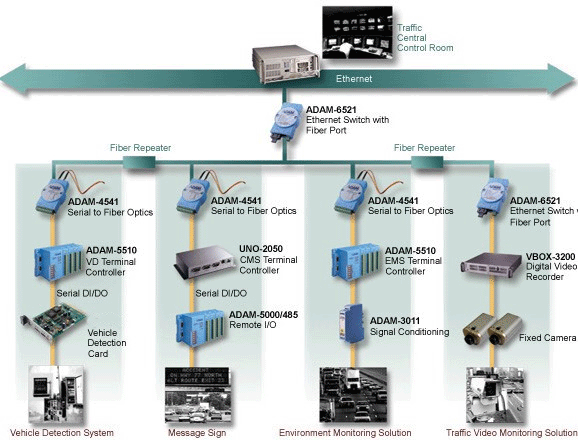 | Figure 2. Intelligent Transportation System Components[27] |
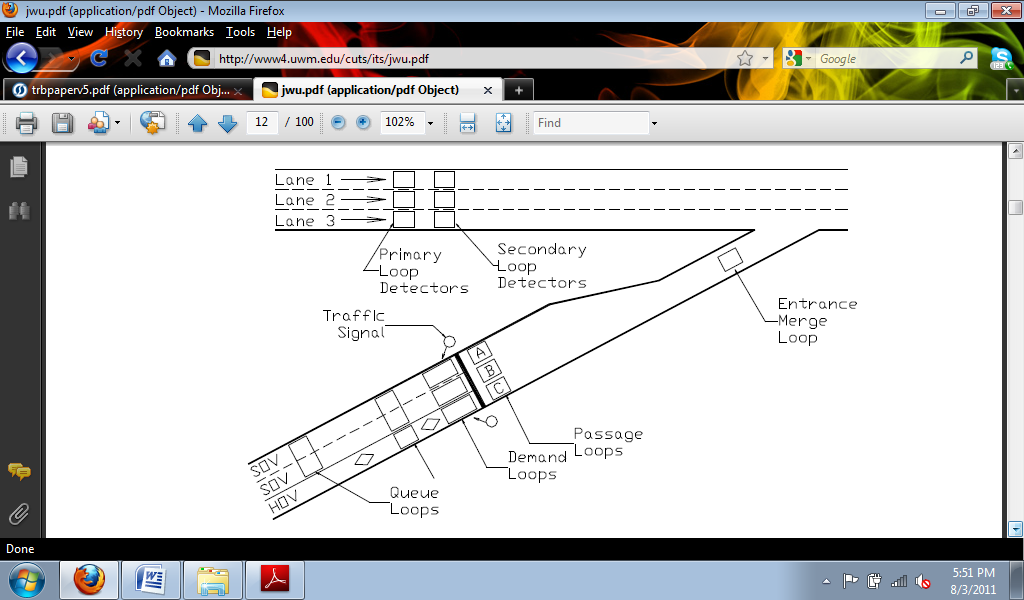 | Figure 3. Metered Freeway Entrance Ramp[37] |
6. Adaptive Traffic Control Systems
- Vehicular traffic is highly variable in nature, and “the control of such traffic requires a high degree of adaptiveness to enable a suitable response to this variability”[40]. In many cases, ITS have evolved into Adaptive Traffic Control Systems (ATCS) that employ actuated control through the use of detection and surveillance devices over a central communications network. The primary objectives of ATCS are to adjust traffic signal patterns to meet estimated traffic demand, communicate vital information to traffic engineers and motorists and respond to traffic congestion resulting from crashes or backups[1][11].ATCS were originally developed in the 1970s and are utilized by transportation agencies in the United States, Australia, United Kingdom, France and Germany. This type of ITS is most efficient in large urban areas with continuous traffic fluctuations as it is capable of adjusting signal timings in real-time based on current traffic conditions, demand and system capacity. In order to perform efficiently, ATCS require extensive detection, surveillance and communications systems when compared to conventional traffic control systems. However, they tend to be less maintenance intensive, relying more on sophisticated operations in order to function smoothly[1].At this time, there is no particular solution that can be applied across all roadway systems. To accommodate the needs of their own unique infrastructures, transportation agencies around the world have independently developed ATCS. The Split Cycle Offset Optimization Technique (SCOOT) and Urban Traffic Optimization by Integrated Automation (UTOPIA) designed in the United Kingdom are known for their efficient adaptive operations in grid networks. Whereas, Adaptive Control Software (ACS) developed in the United States and the Sydney Coordinated Adaptive Traffic System (SCATS) implemented in Australia are recognized for operating best on arterial networks. Due to the fact that each system is unique, comparison of each ATCS is almost impossible. However, the advantages of ATCS are clear as transportation agencies witness reduction in fuel consumption and air pollution, quick responses to traffic fluctuations and improved safety and security[1]. Table 4 provides delay reduction information realized by some ATCS deployments in the United States[41].
|
7. Implementation
- It is important to understand who is affected by traffic signal systems in order to determine the most effective means of detection and control. There are currently over 130 million passenger vehicles registered in the United States. Additionally, there are over 110 million motorcycles, trucks and buses that crowd the country’s arterial roadway systems[42]. The travel time, fuel consumption and safety of motor vehicles are directly affected by traffic signal systems[43]. Critical factors affecting implementation of a traffic signal system include traffic conditions, management conditions and equipment conditions.Management conditions including transportation operations and maintenance personnel must be considered when modifying existing systems or implementing new systems. Factors such as the agency’s level of knowledge and technical expertise may determine how an existing system is modified or a new system is deployed. In order for a traffic signal system to be successfully installed and operated, specifically ITS, it is critical that the owner consults with equipment vendors, receives proper training and hires expert personnel. It is a common misconception that all ITS are completely automated; realistically, they require teams of highly trained traffic engineers and technical support personnel for effective operations and maintenance[1].Another factor that must be evaluated is interoperability, the sharing of information between system components including software and hardware. The lack of standardization in the transportation industry is a common problem that agencies face when determining how to improve their traffic signal systems. With the realization that older equipment is obsolete, some systems have to be completely replaced or decommissioned to avoid the expense. To improve interoperability in traffic signal systems, Siemens Traffic Management Solutions, NEMA and other professional organizations have taken the lead in the development and promotion of industry standards[44-45].
8. Conclusions & Recommendations
- Due to the unrelenting increase of vehicle congestion in urban areas, traffic engineers continue to research new technologies in hope that significant improvements will be made in the safety and efficiency of arterial roadways. The Chinese Ministry of Transportation has recently evaluated a new Traffic State Detector (TSD) that utilizes an advanced image processing technique to survey and control traffic. Although the TSD has the potential to provide many benefits to transportation agencies, the technology is still being developed and needs much improvement[46]. Additionally, researchers at the Massachusetts Institute of Technology are developing an innovative type of Wireless Sensor Network (WSN) designed for simple and economical traffic monitoring, specifically in ATCS. The WSN technology utilizes clusters of sensors to detect traffic and wirelessly transmit real-time information to wired control base stations[47-48]. As a final point, it has been postulated that, in the future, vehicles will have “more advanced collision avoidance systems,” and the “data collection, sharing and dissemination systems established in preceding years will provide a foundation for the early stages of deployment of automated highway systems”[49].The body of scientific evidence reveals known limitations and known benefits of traffic signal systems, and certain factors contributing to the improvement of traffic signal systems over time have been established. To support transportation agencies in implementation decision making, some basic cost-benefit analysis software has been developed at the federal level[50]. There is certainly a need, however, to further investigate the cost effectiveness of different systems to determine if the investment is worth the potential benefits. Such understanding can only be obtained by collecting information from transportation agencies that have contracted traffic signal projects and contractors who have performed the work then isolating and comparing the key variables that influence cost.
References
| [1] | A. Stevanovic, “Adaptive Traffic Control Systems: Domestic and Foreign State of Practice”, National Cooperative Highway Research Program, Washington, DC, 2010. |
| [2] | N. Chaudhary, C. L. Chu, S. Sunkari and K. Balke, “Guidelines for Operating Congested Traffic Signals”, Texas Transportation Institute, College Station, TX, 2010. |
| [3] | Texas Transportation Institute, “Urban Roadway Congestion”, United States Department of Transportation, Washington, DC, 1998. |
| [4] | D. Schrank, T. Lomax and S. Turner, “2010 Urban Mobility Report”, Texas Transportation Institute, College Station, TX, 2010. |
| [5] | J. Ben-Edigbe and I. Ibrahim, “Empirical Delays from Actuated and Optimised Static Signal Settings Compared”, ARPN Journal of Engineering and Applied Sciences, vol. 5, no. 1, pp. 42-48, 2010. |
| [6] | Sabra, Wang & Associates, “Signal Timing Process Final Report”, United States Department of Transportation, Washington, DC, 2003, Online Available: http://ops.fhwa.dot. gov/arterial_mgmt/rpt/sig_tim_proc/index.htm#toc |
| [7] | M. Dixon, “Development of New Actuated Signalized Intersection Performance Measurement Methodologies Using Traffic Controller Input and Output Data”, 2006, Online Available: http://www.webs1.uidaho.edu/signalperformance/ index.htm |
| [8] | J. W. Buckholz, “Traffic Signal Operations Course - The Signal Controller Cabinet”, PDH Enterprises, Morrisville, NC, 2010. |
| [9] | S. R. Sunkari, R. Engelbrecht and K. Balke, “Use of Advance Coordination Features in TxDOT Traffic Signal Controllers”, Texas Transportation Institute, College Station, TX, 2004. |
| [10] | L. Mimbela and L. Klein, “A Summary of Vehicle Detection and Surveillance Technologies Used in Intelligent Transportation Systems”, The Vehicle Detector Clearinghouse, Las Cruces, NM, 2007. |
| [11] | C. M. Walton, K. Persad, Z. Wang, K. Svicarovich, A. Conway and G. Zhang, “Arterial Intelligent Transportation Systems”, Center for Transportation Research, Austin, TX, 2009. |
| [12] | D. Middleton, H. Charara and R. Longmire, “Alternative Vehicle Detection Technologies for Traffic Signal Systems”, Texas Transportation Institute, College Station, TX, 2009. |
| [13] | N. McLawhorn, “Evaluating New Sensor Technologies for Actuated Signals”, Wisconsin Department of Transportation, Madison, WI, 2003. |
| [14] | F. Amiri and E. Minge, “Evaluation of Non-Intrusive Technologies for Traffic Detection”, in Proceedings of Intelligent Transportation Society of America’s Thirteenth Annual Meeting and Exposition, Minnesota Department of Transportation, St. Paul, MN, 2003. |
| [15] | D. Novak, “A Case Study: Benefits Associated with the Sharing of ATMS-Related Video Data in San Antonio, TX, Research and Innovative Technology Administration, 1998, Online Available: http://ntl.bts.gov/lib/jpodocs/repts_te/ 7124.pdf |
| [16] | E. Atkociunas, R. Blake, A. Juozapavicius and M. Kazimianec, “Image Processing in Road Traffic Analysis”, Nonlinear Analysis: Modeling and Control, vol. 10, no. 4, pp. 315-332, 2005. |
| [17] | C. Chen, J. Kwon, J. Rice, A. Skabardonis and P. Varaiya, “Detecting Errors and Imputing Missing Data for Single Loop Surveillance Systems”, Transportation Research Board, Washington, DC, 2002. |
| [18] | R. Rajagopal and P. Varaiya, “Evaluating the Health of California’s Loop Sensor Network”, Transportation Research Board, Washington, DC, 2009. |
| [19] | D. Middleton and R. Parker, “Vehicle Detector Evaluation”, Texas Transportation Institute, College Station, TX, 2002. |
| [20] | Traffic Technology International, “Scotland Records Large Reduction in Road Casualties at Speed Camera Sites”, Traffic Technology Today, 2011, Online Available: http://www. traffictechnologytoday.com/news.php?NewsID=31906 |
| [21] | J. Pack, K. Aguigui and R. Shinn, “Using Copper Wires for ITS Networks: It’s Not Only for Fiber Optics and Wireless Systems”, DKS Associates, 2005, Online Available: http:// www.dksassociates.com/admin/paperfile/Final_rad6C294.pdf |
| [22] | L. Tebow, “Internal Communications in Traffic Signal Control”, IMSA Journal, pp. 28-30, 2004. |
| [23] | D. Gettman, “An Innovative, Ethernet-Based Communications Network Architecture for Integrated Transportation Management Systems”, DKS Associates, 2011, Online Available: http://www.dksassociates.com/admin/paperfile/ka_ sfgo_ether_comm_archit_its_wc_02.pdf |
| [24] | S. Thomas, “Ethernet-Based Communications for the Transportation Industry”, Colorado/Wyoming Institute of Transportation Engineers, 2011, Online Available: http://www. cowyite.org/technical/Ethernet.pdf |
| [25] | D. Vincent, “Wireless Traffic Signal Control”, IMSA Journal, pp. 57-58, 2008. |
| [26] | United States Department of Transportation, “Traffic Signal Control Systems”, Research and Innovative Technology Administration, 2011, Online Available: http://ntl.bts.gov/lib/ jpodocs/edldocs1/13480/ch3.pdf |
| [27] | Advantech, “Smooth Traffic Flow with Advantech's PC-Based Intelligent Transportation Systems”, Automation Link Industrial Automation Group, 2003, Online Available: http://www.advantech.com.tw/ia/newsletter/Transportation_page2.htm |
| [28] | S. M. Turner and W. R. Stockton, “A Proposed ITS Evaluation Framework for Texas”, Texas Transportation Institute, College Station, TX, 1999. |
| [29] | J. M. Mounce, G. Ullman, G. Pesti and V. Pezoldt, “Guidelines for the Evaluation of Dynamic Message Sign Performance”, Texas Transportation Institute, College Station, TX, 2007. |
| [30] | T. Kristof, M. Lowry and G. S. Rutherford, “Assessing the Benefits of Traveler and Transportation Information Systems”, Washington State Transportation Center, Seattle, WA, 2005. |
| [31] | C. Zimmerman, P. Bolton, M. Raman, T. Kell, S. Unholz and C. Bausher, “Communicating With the Public Using ATIS During Disasters: A Guide for Practitioners”, United States Department of Transportation, Washington, DC, 2007. |
| [32] | J. H. Wang, M. Keceli and V. Maier-Speredelozzi, “Effect of Dynamic Message Sign Messages on Traffic Slow Downs”, Transportation Research Board, Washington, DC, 2009. |
| [33] | K. A. Harder and J. R. Bloomfield, “The Effectiveness and Safety of Traffic and Non-Traffic Related Messages Presented on Changeable Message Signs - Phase II”, Minnesota Department of Transportation, St. Paul, MN, 2008. |
| [34] | M. Carter, “Metropolitan Model Deployment Initiative San Antonio Evaluation Report”, United States Department of Transportation, Washington, DC, 2000. |
| [35] | United States Census Bureau Population Division, “2011 Population Estimates”, United States Department of Commerce, Washington, DC, 2012. |
| [36] | Federal Highway Administration, “Deploying and Operating Integrated Intelligent Transportation Systems”, United States Department of Transportation, Washington, DC, 2001. |
| [37] | J. Wu, “Traffic Diversion Resulting from Ramp Metering”, University of Wisconsin, Milwaukee, WI, 2001, Online Available: http:// www4.uwm.edu/cuts/its/jwu.pdf |
| [38] | Apogee/Hagler Bailly, “Intelligent Transportation Systems: Real World Benefits”, United States Department of Transportation, Washington, DC, 1998. |
| [39] | Federal Highway Administation, “ITS Benefits: Continuing Successes and Operational Test Results”, United States Department of Transportation, Washington, DC, 1997. |
| [40] | S. P. Shephard, “A Review of Traffic Signal Control”, Institute of Transport Studies, Leeds, UK, 1992. |
| [41] | J. M. Sussman, V. Pearce, B. Hicks, M. Carter, J. E. Lappin, R. F. Casey et al., “What Have We Learned About Intelligent Transportation Systems?”, United States Department of Transportation, Washington, DC, 2000. |
| [42] | Bureau of Transportation Statistics, “National Transportation Statistics”, Research and Innovative Technology Administration, 2006, Online Available: http://www.bts.gov/ publications/national_transportation_statistics/2005/html/table_01_11.html |
| [43] | National Transportation Operations Coalition, “National Traffic Signal Report Card Executive Summary”, United States Department of Transportation, Washington, DC, 2007. |
| [44] | M. J. Chase and R. J. Hensen, “Traffic Control Systems - Past, Present and Future”, Journal of Transportation Engineering, vol. 116, no. 6, pp. 703-713, 1990. |
| [45] | D. VanDillen, “Benefits of Standardization - Traffic Signal Control”, Baltimore Metropolitan Council, 2007, Online Available: http://www.baltometro.org/ITS/TSF07-2A-Benefits Standardization.pdf |
| [46] | L. Hao, Y. Yuan and N. Shuyun, “Assessment of an Advanced Traffic State Detector”, Advanced Materials Research, vol. 108-111, pp. 811-816, 2010. |
| [47] | A. N. Knaian, “A Wireless Sensor Network for Smart Roadbeds and Intelligent Transportation Systems”, Massachusetts Institute of Technology, Cambridge, MA, 2000. |
| [48] | K. M. Yousef, J. N. Al-Karaki and A. M. Shatnawi, “Intelligent Traffic Light Flow Control System Using Wireless Sensor Networks”, Journal of Information Science and Engineering, vol. 26, pp. 753-768, 2010. |
| [49] | G. W. Euler and H. D. Robertson, “National ITS Program Plan”, United States Department of Transportation, Washington, DC, 1995. |
| [50] | K. Persad, C. M. Walton and Z. Wang, “Implementation Issues and Strategies for Deployment of Traveler Information Systems in Texas”, Center for Transportation Research, Austin, TX, 2006. |
 Abstract
Abstract Reference
Reference Full-Text PDF
Full-Text PDF Full-text HTML
Full-text HTML